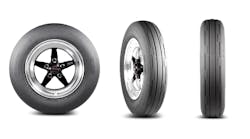Now's the Time to Boost Your Market Share: Dealer Channel Continues to Gain Ground
When’s the last time you took a good, hard look at what your competitors are doing? And when I say “competitors,” in this case, I’m not referring to other independent tire dealers.
I’m talking about mass merchandisers, warehouse clubs, auto dealerships and tire manufacturer-owned stores.
These entities have always been part of the competitive landscape. (Remember when Montgomery Ward sold tires? I wonder how many people even remember brick-and-mortar Montgomery Ward stores?)
It’s easy to take these competitive channels for granted, if for no other reason than simply because they have always “been there.”
And I’m sure you probably have done an excellent job of neutralizing their impact on your business. This factor probably explains why these alternate channels’ collective grip on the market seems to be waning.
In 2010, mass merchandisers made up 14.5% of the United States replacement consumer tire sales channel, according to MTD research. Warehouse clubs made up 9.5%. Tire company-owned stores accounted for 7%. (Back then, three tire manufacturers - Bridgestone Americas Inc., Goodyear Tire & Rubber Co. and Nokian Tyres plc - owned and operated retail outlets in the U.S. Nokian recently exited this space by selling 10 Vianor Tire Center locations to an independent tire dealership, Gill Point S Tire & Auto Service.)
Car dealerships had 6% of the market roughly 10 years ago. Service stations comprised 1.5%. And what we call “miscellaneous” outlets made up 1.5%.
Which group comprised the biggest distribution channel? Independent tire dealers, who, together, enjoyed 60% share at that time.
Fast forward to 2019, the latest year for which we have statistics. (The next edition of the MTD Facts Issue, available this January, will feature updated numbers for 2020.)
Last year, independent tire dealerships made up a whopping 63% of the market - the only channel, other than auto dealerships (9.5%) and miscellaneous outlets (2.5%), to have gained ground over the last decade.
Mass merchandisers’ share of the U.S. market fell to 10.5%. Warehouse clubs dropped to 8.5%. And tire manufacturer-owned stores experienced a 1% decline from 2010 to around 6% of the market. Service stations fell off the list.
Of course, since 2010, the e-commerce channel has gained momentum. Many of you have capitalized on this by either offering your own, proprietary e-commerce portal or by using existing platforms to generate incremental revenue.
Before I wrap up this look at competitive replacement tire sales channels, I thought it would be interesting to examine their respective positions within the market some 20 years ago.
Mass merchandisers made up 16.5%. Tire company-owned stores and warehouse clubs were tied at 8% each. Service stations comprised 4% of the market. Auto dealerships made up 2.5%. Miscellaneous outlets had 1.5% share. And independent tire dealers still dominated at 59.5%.
Will we eventually see a time when independent tire dealers make up 65% of the U.S. replacement tire market? How about 70%?
I wouldn’t bet against it.
Now more than ever, tire buyers want to do business with sellers whom they trust - sellers who take a genuine interest in their needs and go out of their way to deliver consistently exceptional service.
This is where you excel. And I will wager that this is how you will continue to capture even more share of your own, local market.
If you have any questions or comments, please email me at [email protected].




